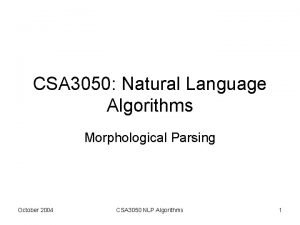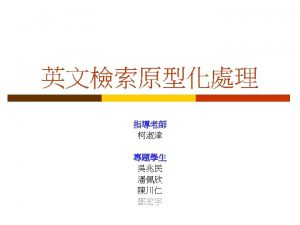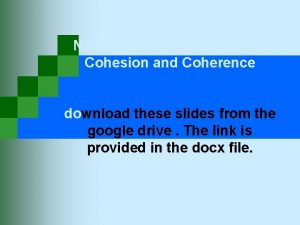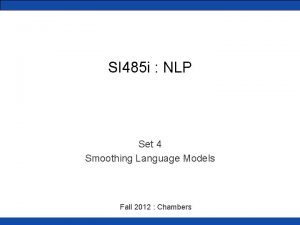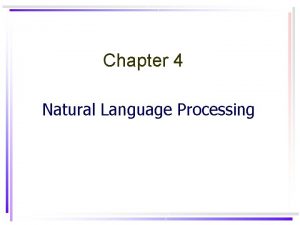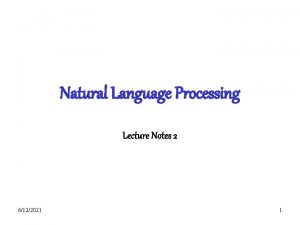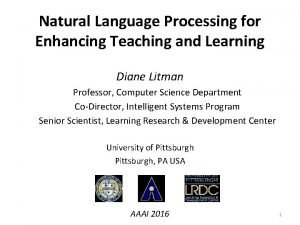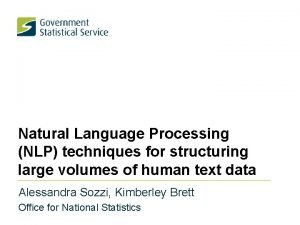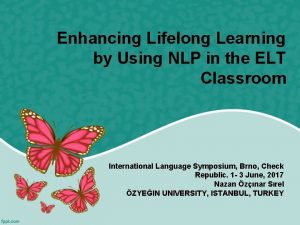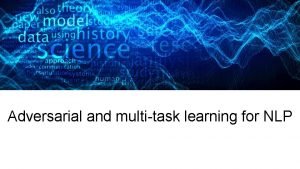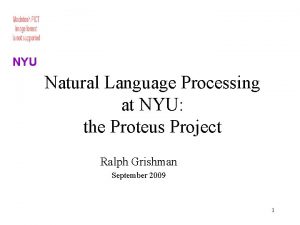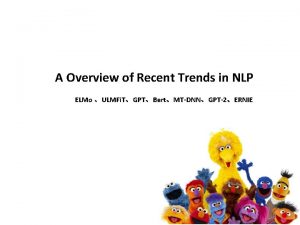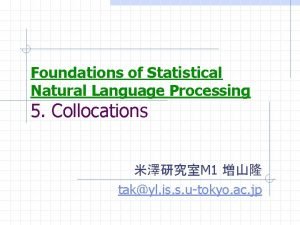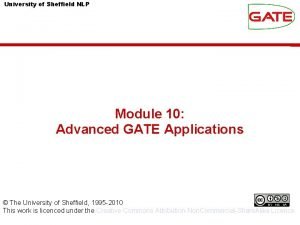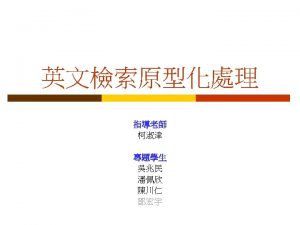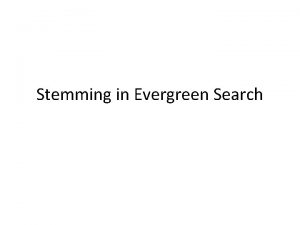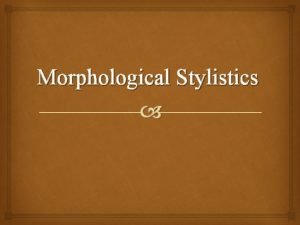NLP Text Similarity Morphological Similarity Stemming Morphological Similarity



















- Slides: 19

NLP

Text Similarity Morphological Similarity: Stemming

Morphological Similarity • Words with the same root: – – – scan (base form) scans, scanned, scanning (inflected forms) scanner (derived forms, suffixes) rescan (derived forms, prefixes) rescanned (combinations)

Stemming • Definition – To stem a word is to reduce it to a base form, called the stem, after removing various suffixes and endings and, sometimes, performing some additional transformations • Examples – scanned → scan – indication → indicate • Note – In practice, prefixes are sometimes preserved, so rescan will not be stemmed to scan

Porter’s Stemming Method • History: – Porter’s stemming method is a rule-based algorithm introduced by Martin Porter in 1980 – The paper (“An algorithm for suffix stripping”) has been cited more than 7, 000 times according to Google Scholar • Input: – The input is an individual word. The word is then transformed in a series of steps to its stem • Accuracy: – The method is not always accurate

Porter’s Algorithm • Example 1: – Input = computational – Output = comput • Example 2: – Input = computer – Output = comput • The two input words end up stemmed the same way

Porter’s Algorithm • The measure of a word is an indication of the number of syllables in it – – Each sequence of consonants is denoted by C Each sequence of vowels is denoted as V The initial C and the final V are optional So, each word is represented as [C]VCVC. . . [V], or [C](VC){m}[V], where m is its measure

Examples of Measures • • m=0: I, AAA, CNN, TO, GLEE m=1: OR, EAST, BRICK, STREET, DOGMA m=2: OPAL, EASTERN, DOGMAS m=3: EASTERNMOST, DOGMATIC

Porter’s Algorithm • Transformation patterns – The initial word is then checked against a sequence of transformation patterns, in order. • Example – (m>0) ATION -> ATE medication -> medicate – Note that this pattern matches medication and dedication, but not nation. • Actions – Whenever a pattern matches, the word is transformed and the algorithm restarts from the beginning of the list of patterns with the transformed word. – If no pattern matches, the algorithm stops and outputs the most recently transformed version of the word.

Example Rules • Step 1 a SSES -> IES -> SS I SS ø presses lies press lots -> -> press li press lot • Step 1 b (m>0) EED -> EE refereed -> referee (doesn’t apply to bleed since m(‘BL’)=0)

Example Rules • Step 2 (m>0) (m>0) (m>0) ATIONAL IZER ENTLI OUSLI IZATION ATOR IVENESS ALITI BILITI -> -> -> ATE TION IZE ENT OUS IZE ATE IVE AL BLE inflational notional nebulizer intelligentli analogousli realization predication indicator attentiveness realiti abiliti -> -> -> inflate notion nebulize intelligent analogous realize predicate indicate attentive real able

• • Step 3 (m>0) (m>0) Step 4 (m>1) (m>1) (m>1) Example Rules ICATE -> IC ATIVE -> ø ALIZE -> AL ICAL -> IC FUL -> ø NESS -> AL -> ø ANCE -> ø ER -> ø IC -> ø ABLE -> ø IBLE -> ø EMENT -> ø replicate -> replic informative -> inform realize -> real electrical -> electric blissful -> bliss tightness -> tight appraisal -> apprais conductance -> conduct container -> contain electric -> electr countable -> count irresistible -> irresist displacement -> displac investment -> invest respondent -> respond

Examples • Example 1: – – Input = computational Step 2: replace ational with ate: computate Step 4: replace ate with ø: comput Output = comput • Example 2: – Input = computer – Step 4: replace er with ø: comput – Output = comput • The two input words end up stemmed the same way

External Pointers • Online demo – http: //text-processing. com/demo/stem/ • Martin Porter’s official site – http: //tartarus. org/martin/Porter. Stemmer/

Quiz • How will the Porter stemmer stem these words? construction increasing unexplained differentiable ? ? • Check the Porter paper (or the code for the stemmer) in order to answer these questions. • Is the output what you expected? – If not, explain why.

Answers to the Quiz construction increasing unexplained differentiable ? ? construction construct increasing increas unexplained unexplain differentiable differenti

NACLO Problem • Thorny Stems, NACLO 2008 problem by Eric Breck – http: //www. nacloweb. org/resources/problems/2008/N 2008 -H. pdf

Solution to the NACLO problem • Thorny Stems – http: //www. nacloweb. org/resources/problems/2008/N 2008 -HS. pdf

NLP
 Nlp text similarity
Nlp text similarity Nlp text similarity
Nlp text similarity Morphological parsing in nlp
Morphological parsing in nlp Benefits stemming from space exploration
Benefits stemming from space exploration Stemming algorithms
Stemming algorithms Text to text text to self text to world
Text to text text to self text to world Coherent and cohesion meaning
Coherent and cohesion meaning Nlp radiology reports
Nlp radiology reports Why is nlp hard in terms of ambiguity?
Why is nlp hard in terms of ambiguity? Nlp smoothing
Nlp smoothing Discourse integration in nlp
Discourse integration in nlp Nlp lecture notes
Nlp lecture notes Nlp for education
Nlp for education What is nlp techniques
What is nlp techniques 4 pillars of nlp
4 pillars of nlp Multi task learning nlp
Multi task learning nlp Adam meyers nyu
Adam meyers nyu Elmo nlp
Elmo nlp Collocation nlp
Collocation nlp Gate nlp
Gate nlp


